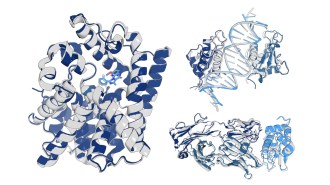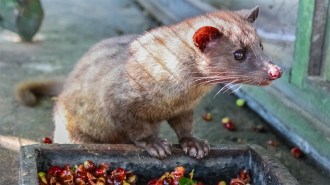- More than 2 years ago
For most people, catching a whiff of someone’s pizza breath doesn’t inspire cravings for a slice. But for rodents, any food smell combined with breath odor sends an irresistible “eat this” message to the brain. Now scientists have uncovered exactly how the signal gets transmitted.

Carbon disulfide, a byproduct of metabolism found in the breath of many mammals, stimulates a subset of cells in the mouse nose, scientists report online July 15 in Current Biology. When one mouse smells another’s breath, these nose cells trigger a signal that ultimately is transmitted to specialized structures within the mouse brain that associate an incoming odor with food that’s safe to eat.
“One mouse is saying, ‘My friend here just ate some food that smells like this — and he’s still breathing, he’s alive — so it must be safe,” says study coauthor Steven Munger of the University of Maryland School of Medicine in Baltimore.
Special nasal cells, called GC-D cells, seem to respond to the CS2 in rodent breath, experiments by Munger and his colleagues reveal. A mouse that smells cinnamon on a buddy’s breath will choose cinnamon-scented food over any other flavor, the researchers found. And it doesn’t even have to be another mouse: Cotton balls laced with a food odor and CS2 did the trick. But mice without working GC-D cells lost the ability to interpret this chemical message and they didn’t copy their compatriots’ food choices, the team reports.
The new work provides a molecular explanation for how these rodents learn what’s OK to eat, says neuroscientist Emily Liman of the University of Southern California in Los Angeles. For people and other primates, food preferences are mostly learned visually (or compelled via threats of no dessert). But for nocturnal creatures such as rodents, visual cues are limited. So it makes sense that there’s a scent signal, Liman says.
This safe-to-eat signal is so powerful that a mouse who has eaten poison will return for more if it catches a whiff of the poison on another mouse’s breath, says behavioral scientist Bennett Galef of McMaster University in Hamilton, Canada. “The strength of this social learning on food choice is huge,” says Galef, whose research revealed that mixing CS2 with rat poison drew four times as many rodents to the bait.
In most primates — including people — the gene in charge of making the GC-D cells no longer functions, though it appears to work in dogs and presumably many other mammals, Liman says. Perhaps this loss of specialized cells for detecting CS2 coincided with other changes in the primate lifestyle, including a shift to daytime activity and improved eyesight, which made vision as important as smell for evaluating food.






